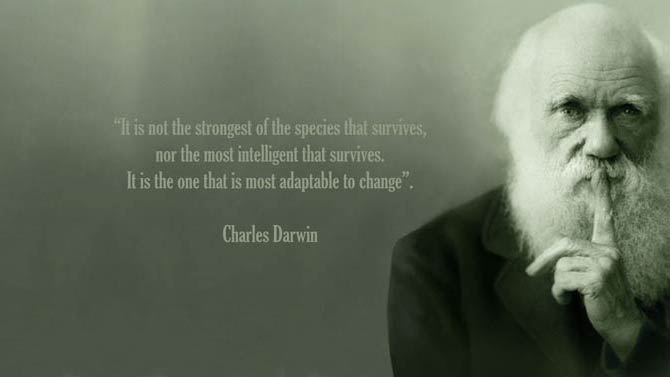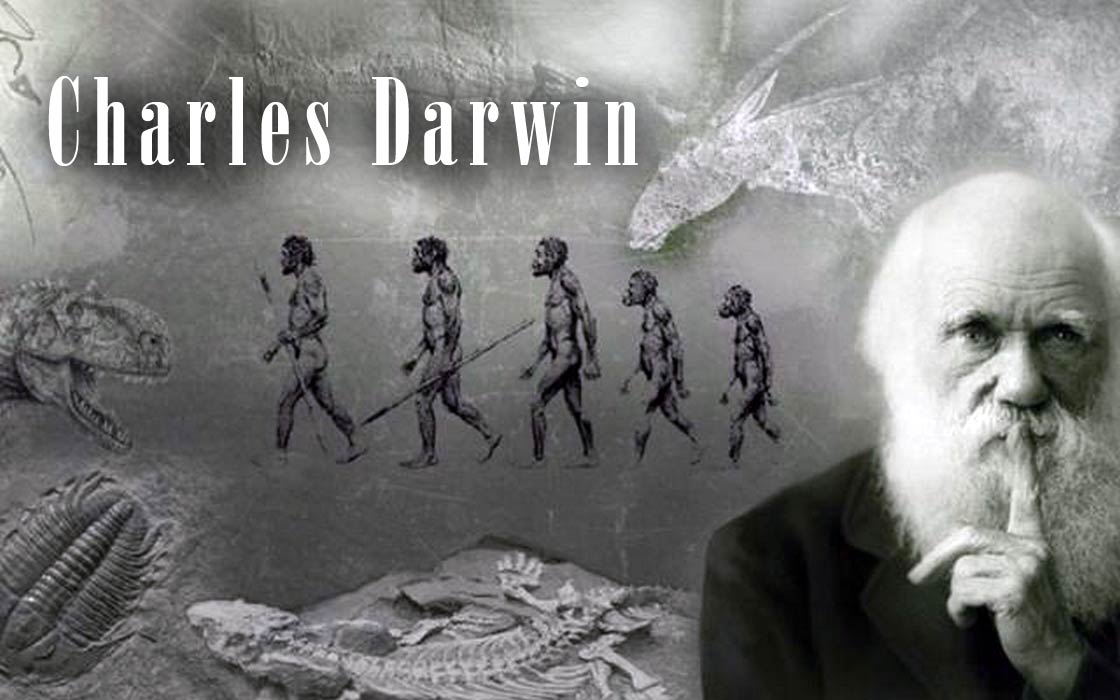Charles Darwin and his story
Charles Darwin – the founder of the Theory of Evolution
The father of the theory of evolution, a great naturalist, but also a geologist, which is often forgotten – this is Charles Darwin. Were it not for this man, the natural sciences would be completely different today. Reflections and echoes of the theory of evolution can also be found in philosophy or, more broadly, in the humanities (including literary theory). Although today Charles Darwin is primarily the hero of many internet memes and anecdotes as the one who showed that man comes from a monkey, his contribution to science and the development of the present day is invaluable. His theory of natural selection revolutionized the world of science. Often, along with Frederick Nietzsche and Sigmund Freud, he is counted among the main thinkers and founders of our era.

Early Years and Education
Charles Robert Darwin was born in Shrewsbury (England) in 1809, on February 12 to be precise. The family was strongly scientific, as Charles Darwin’s father was a doctor, while his grandfather was a naturalist, and it was from him that young Darwin first heard about the phenomenon of evolution.
Already at the age of eight, he was keenly interested in natural history and natural sciences. He attended an Anglican school and then went to Edinburgh University to study to become a doctor.
Not much came out of it, however, because Charles Darwin was terribly bored with classes, especially those in anatomy and surgery. Medicine was not something he dreamed of and he stopped attending classes fairly quickly, which caused himself more and more problems with his studies.
He did not care at all, however, because he had much more interesting classes: he studied secretly from a liberated, black slave (and a traveler who explored South America, and above all, the richness of its tropical forests). What was he doing there? Well, he learned to prepare exhibits, or to put it simply – to stuff animals to resemble live specimens. It turned out to be much more interesting than boring university classes.
Karol began to follow this path and in the next year of studies, he took the opportunity to join a group of lovers and enthusiasts of natural history. He studied the life cycles of small marine organisms, he was also interested in anatomy, not of humans, but of marine invertebrates.

Darwin also began training in geology and started working on the collections of the Royal Museum in Edinburgh. All this made his university results more and more pitiful.
The father lost his patience and transferred his son to Christ’s Collage to educate him at least as an Anglican clergyman, since he could not be made a doctor.
Darwin, instead of dealing with theology and prayers, began to … collect crickets 🙂 He also met many excellent naturalists and began to explore the teachings that they called natural theology.
It was amazing that when it came time for the Christ’s Collage exams, Darwin turned out to be one of the better ones, proving that he was an extremely talented, intelligent and broad-minded man.
He studied there until 1831, deepening his knowledge in such areas as the philosophy of nature, the mechanisms of species adaptation processes in relation to the role of God in nature, he also learned inductive reasoning.
The theory alone was no longer sufficient for him, he wanted to conduct research on his own and become an explorer. Going on a geology course to Wales to map the layers and layout of the land was not enough for him.

A trip of a lifetime to South America
When, thanks to the protection of John Henslow, Darwin set out on a several-year voyage to South America, he had no idea that he would return as a famous and recognized scientist.
Darwin set sail on December 27, 1831, and the journey took almost 5 years. The purpose of the expedition was cartography, or more specifically, mapping the coast of this continent, which still remained a great mystery. Darwin sailed mostly as a helper and a bit of an ordinary tourist. No one had any idea that he was going to use the expedition to gather evidence supporting the scientific theory of his life – the theory of evolution and natural selection.
Darwin went ashore whenever he could and did his research there. The mapping of the coast was done by others, while he collected specimens and described them in his journal and in letters sent to his family.
He was most interested in marine invertebrates with which he had already had some experience. While the preparation was not problematic, the further research was black magic for Darwin, he had no experience or knowledge, so he did it instinctively, and he prepared and took most of the specimens with him so that he could examine them more thoroughly when he returned to England.
It started with geology, more precisely with shells collected in volcanic rocks in Cape Verde, then it was time for paleontology – in Patagonia he discovered the skeletons of extinct mammals.
While exploring the land, he also learned about the lives and beliefs of Indian tribes and trained in anthropology. The more he saw and studied, the more he disagreed with his old masters’ theories of the continuity of species without any disturbance.
Darwin also had many adventures – he traveled with Indian tribes who filled him with terror by their wildness and animalism, he learned what an earthquake is and how it affects the movements of water masses, he discovered submerged and fossilized trees.
The time has finally come for the famous Galapagos Islands.

Secrets of the Galapagos Islands
The Galapagos Islands were perfect for research because they were fairly young geologic formations and were far from other land. Darwin was primarily looking for relationships: how do current species relate to previous species? What makes them different?
He was helped by birds, the same species he had seen in Chile, yet slightly differently developed. This got him thinking about why this happens, what factor is decisive in the development of a species. He also studied the famous turtles, of course, but the Galapagos Islands were just the beginning, then it was time for Australia, where in turn the oldest forms of life on Earth are preserved. Darwin was interested in platypuses, among other things.
In his notes, letters, and later also in his emerging work on natural history, he began to emphasize his suspicion that the stability of species and the laws of their development without disturbance were to be questioned. Thus was born the theory of evolution.

Theory of evolution and natural selection
Darwin’s primary concern was to thoroughly examine the samples and exhibits he had brought with him from his sea voyages. Although his name was already known in the scientific world (letters and sketches of scientific articles reached the land during a several-year journey), no one was eager to help.
But when it finally worked out, the results were surprising. It turned out that Darwin brought exhibits of extinct animal species. These ancient creatures, however, were related to species living today.
Darwin’s geological theories, according to which species evolve and the earth’s physical and chemical factors affecting them were similar then and now, laid the foundations for even more daring theories: species changed and will continue to change according to strictly defined laws of nature.
It became clear that one species of creature slowly transformed into another, more favorable in given natural conditions, and that this has always been the case. Darwin called it the transmutation of species, and he was constantly researching, drawing family trees, and revising his Journal. He worked so hard that he strained his health.

In March 1838, he accepted the job of secretary of the Geological Society, which was extremely ennobling but also exhausting because Darwin had a lot of other responsibilities.
However, thanks to his new job, he has impressively broadened his knowledge of the evolution of species. He also did not hesitate to talk to people who were not scientists, but had great practical knowledge, for example, they bred pigeons.
Darwin was not afraid to talk to anyone, as long as it could provide him with valuable new information. He also studied the ability of organisms to survive and the ability to pass positive, newly developed traits to their offspring.
He discovered that in nature only the strongest survive, because there simply wouldn’t be enough space for everyone. This is how the theory of natural selection was born. He worked on it for 15 next years.
The announcement of the theory of natural selection took place under rather stressful conditions – Darwin had to cooperate at the last minute when it turned out that he was not the only one to study the theory of evolution. The very announcement of the theory met with almost only criticism, but the book (On the Origin of Species), already published in 1859, was met with great interest.

How did the world embrace Darwin’s theories?
As with any great discovery, there was controversy and eventually distortions of his theory and attempts to use it later for political purposes (Darwin was linked to eugenics).
Man comes from a monkey (an ape)?
Darwin was most controversial for something he did not actually write, but others did: that human is descended from apes. It was unacceptable to many that Darwin rejected the role of the supernatural and focused solely on the iron and inexorable laws of nature. From his arguments, it was clear that nature is self-sufficient and corrects its mistakes precisely through evolution, enhancing those features that guarantee survival (which is what we call natural selection).
There was no place in Darwin’s world for a God to interfere with the transformation of species. But there was room for the strongest, and the weak had to die because they were insufficiently adapted. This applied to all nature, and therefore – to the indignation of many circles – also to the human species.
The Church received these revelations differently. Some saw the hand of God in natural selection and accepted the theory, others rejected it firmly and treated it as impious. According to Darwin himself, the phenomena of natural selection and the evolution of species in no way contradicted what he called natural theology.
Nature turned out to be a divine, self-regulating mechanism. The Oxford public debate in 1860 proved to be the victory of the theory of evolutionism over the theory of creationism, according to which God created the world in one fell swoop, and if any new species arose, it was only because of God creating them, not evolving them from old forms. The Origin of Species has over time become one of the most popular scientific books that has been translated into many languages.

On the Origin of Man
Darwin did not rest on his laurels. For him, everything he wrote so far was only the beginning of further research into the essence of man, the secret of sexual selection and reproduction. Although his health deteriorated, he continued his research for over 20 years. He was primarily concerned with pollinating flowers and the ways in which flowers attract and adapt to insects. He tracked ecological relationships and plant movements. He also became a botanist from a geologist and zoologist.
The work he created grew so large that he had to divide it into a plant-animal part (The Variation of Animals and Plants under Domestication) and a human part. He did not manage to finish the second one – the book on human natural selection was not published during his lifetime, which must have been very sad for him.
However, he managed to prove that humans are subject to the same laws as animals (because they are animals) and that they are subject to the phenomenon of sexual selection. He also separated the cultural and typically physical racial characteristics of people and proved the origin of people from one, the same species. In those days, these were truly revolutionary theories. He died a national hero, had a state funeral and all the honors. He said goodbye to life on April 19, 1882.

Charles Darwin and important dates
- Darwin was born on February 12, 1809
- In 1818, he began attending an Anglican school with his brother Erasmus
- In 1825 he enrolled at the University of Edinburgh
- On December 27, 1831, he set off on an almost five-year voyage on the ship HMS Beagle to the shores of South America and Australia
- In March 1838, he accepted the position of secretary of the Geological Society, and on January 24, 1839, he was elected a member of the Royal Society.
- On January 29, 1838, he married Emma Wedgwood
- On November 22, 1859, his most important work, On the Origin of Species, was released to bookstores
- He died on April 19, 1882

Charles Darwin – interesting facts
- Charles Darwin married rather reluctantly, only after taking stock of the profits and losses. Marriage was a waste of time and energy for him, but he considered the other human being as a better companion than the dog.
- Darwin’s wife was his cousin, which may have contributed to many diseases among their offspring. Two children died in infancy and one of the daughters at the age of 10. Parents were greatly affected by her loss.
- Darwin spent two months on the famous Galapagos Islands. However, he did not only watch turtles there, as is commonly believed. His attention was drawn to birds of the finch species. They were later referred to as Darwin’s finches.

Discussion / Podcast on Charles Darwin
Let’s listen to a discussion about Charles Darwin – the founder of the Theory of Evolution.



















